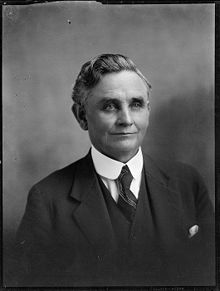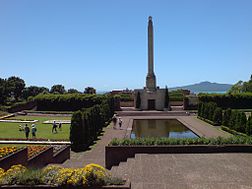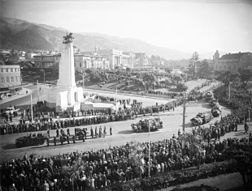- Michael Joseph Savage
-
The Right Honourable
Michael Joseph Savage
MP
Michael Joseph Savage in the 1920s. 23rd Prime Minister of New Zealand In office
6 December 1935 – 27 March 1940Monarch George V
Edward VIII
George VIGovernor General George Monckton-Arundell Preceded by George William Forbes Succeeded by Peter Fraser Member of the New Zealand Parliament
for Auckland WestIn office
1919 – 1940Succeeded by Peter Carr Personal details Born 23 March 1872
Tatong
Victoria
AustraliaDied 27 March 1940 (aged 68)
Wellington
New ZealandPolitical party Labour Profession Trade unionist Religion Initially Roman Catholicism,
then Rationalism,
then Roman Catholicism againMichael Joseph Savage (23 March 1872 – 27 March 1940) was the first Labour Prime Minister of New Zealand.
Contents
Early life
Born in Tatong, Victoria, Australia, Savage first became involved in politics while working in that state. He emigrated to New Zealand in 1907. There he worked in a variety of jobs, as a miner, flax-cutter and storeman, before becoming involved in the union movement. Savage initially opposed the formation of the 1910 New Zealand Labour Party as he viewed the grouping as insufficiently socialistic. Instead he became the chairman of the New Zealand Federation of Labour, known as the "Red Feds".
Political career
Socialist origins
Parliament of New Zealand Years Term Electorate Party 1919–1922 Labour 1922–1925 Labour 1925–1928 22nd Auckland West Labour 1928–1931 Labour 1931–1935 24th Auckland West Labour 1935–1938 25th Auckland West Labour 1938–1940 Labour In the 1911 general election Savage unsuccessfully stood as the Socialist candidate for Auckland Central. During World War I he opposed conscription, arguing that the conscription of wealth should precede the conscription of men. After the war the voters of the Auckland West electorate put Savage into Parliament as a Labour member in the 1919 general election. He became one of eight Labour Members of Parliament, and in due course became the party leader following the death of Harry Holland in 1933. He helped engineer the Labour/Ratana alliance (formalised in 1936).
Prime Minister
During the depression, Savage toured the country, and became an iconic figure. An excellent speaker, he became the most visible politician in the land, and led Labour to victory in the 1935 election. Along with the Premiership he appointed himself the position of Minister of Foreign Affairs and Minister of Maori Affairs. The first Labour government swiftly proved popular and easily won the 1938 general election with an increased popular mandate. Savage, suffering from cancer of the colon at the time, had delayed seeking treatment to participate in the election campaign. He died from the cancer in 1940.
Savage led the country into World War II, officially declaring war on Nazi Germany on 3 September 1939, just hours after Britain.[1] Unlike Australia, which felt obligated to declare war, as it too had not ratified the Statute of Westminster, New Zealand did so as a sign of allegiance to Britain, and in recognition of Britain's abandoning its former appeasement of the dictators, a policy that New Zealand had opposed. This led to Prime Minister Savage declaring (from his bed) two days later that:
With gratitude for the past and confidence in the future we range ourselves without fear beside Britain. Where she goes, we go; where she stands, we stand. We are only a small and young nation, but we march with a union of hearts and souls to a common destiny.
Savage brought an almost religious fervour to his politics. This, and his death while in office, has made him become something of an iconic figure to the Left. The architect of the welfare state (see Social welfare in New Zealand), his picture reportedly hung in many Labour supporters' homes. Savage rejected rationalism during later life and returned to his Catholic roots. His state funeral included a Requiem Mass celebrated at the Basilica of the Sacred Heart, Hill St, Wellington before his body was taken amidst general and public mourning by train to Auckland where he was interred initially in a temporarily adapted harbour defence gun installation. He was soon after removed to a side chapel of St Patrick's Cathedral in Auckland, while a national competition was announced, decided, and the winning design of the monumental tomb and memorial gardens at Bastion Point constructed, forming his permanent resting site. While younger generations have less awareness of him, many older New Zealanders continue to revere him.
Death and commemoration
He was a life-long bachelor, and lived with Alf and Elizabeth French in Auckland from 1908 until he died. Alf came to New Zealand in 1894 on the ship Wairarapa which was wrecked on Great Barrier Island, and helped in the rescue of a girl. Savage also served as the patron of the New Zealand Rugby League.[2]
Savage lies buried at Bastion Point on Auckland's Waitemata Harbour waterfront in the Savage Memorial, a clifftop mausoleum crowned by a tall minaret, and fronted by an extensive memorial garden and reflecting pool.
References
- ^ "Fighting for Britain – NZ and the Second World War". Ministry for Culture and Heritage. 2 September 2008. http://www.nzhistory.net.nz/war/second-world-war/fighting-for-britain.
- ^ Jessup, Peter (12 October 2002). "Kiwi players let their hair down at Clark bash". The New Zealand Herald. http://www.nzherald.co.nz/nz/news/article.cfm?c_id=1&objectid=2998849. Retrieved 25 October 2011.
Further reading
- Gustafson, Barry (1986). From the cradle to the grave: a biography of Michael Joseph Savage. Auckland: Reed Methuen. ISBN 0474001385.
External links
Premiers and Prime Ministers of New Zealand Sewell · Fox · Stafford · Domett · Whitaker · Weld · Waterhouse · Vogel · Pollen · Atkinson · Grey · Hall · Stout · Ballance · Seddon · Hall-Jones · Ward · Mackenzie · Massey · Bell · Coates · Forbes · Savage · Fraser · Holland · Holyoake · Nash · Marshall · Kirk · Rowling · Muldoon · Lange · Palmer · Moore · Bolger · Shipley · Clark · Key
Edward VIII abdication crisis Main protagonists Other persons involved Joseph Lyons (Prime Minister of Australia) · William Lyon Mackenzie King (Prime Minister of Canada) · Éamon de Valera (Prime Minister of the Irish Free State) · Michael Joseph Savage (Prime Minister of New Zealand) · J. B. M. Hertzog (Prime Minister of South Africa) · Stanley Baldwin (Prime Minister of the United Kingdom) · Cosmo Gordon Lang (Archbishop of Canterbury) · Alfred Blunt (Bishop of Bradford) · John Theodore Goddard (Mrs. Simpson's solicitor) · Alexander Hardinge (Edward VIII's private secretary) · Prince Albert, Duke of York (Edward VIII's brother, later George VI) · Queen Mary (Edward VIII's mother) · Ernest Aldrich Simpson (Mrs. Simpson's second husband)Legal documents Cultural depictions Category Categories:- Prime Ministers of New Zealand
- New Zealand people of Irish descent
- Edward VIII abdication crisis
- New Zealand foreign ministers
- New Zealand Labour Party MPs
- New Zealand Labour Party leaders
- New Zealand Roman Catholics
- People from Victoria (Australia)
- Australian emigrants to New Zealand
- New Zealand miners
- 1872 births
- 1940 deaths
- Leaders of the Opposition (New Zealand)
- New Zealand conscientious objectors
- Burials in Auckland
Wikimedia Foundation. 2010.


